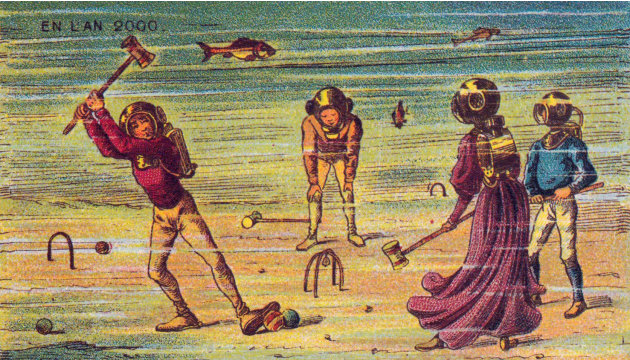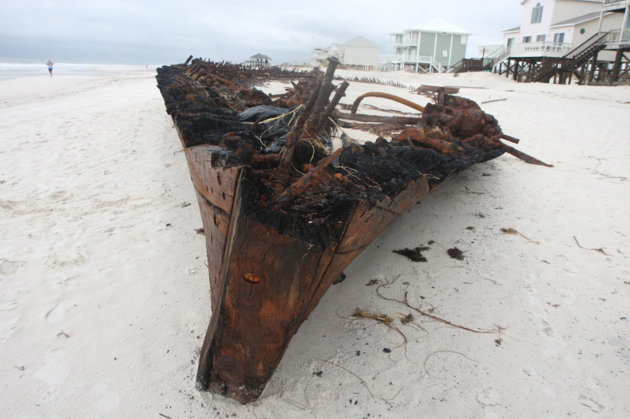BEAUFORT — State underwater archaeologists
headed out Tuesday in search of artifacts at the Queen Anne’s Revenge
shipwreck in Beaufort Inlet.
This is the third week of an eight-week dive expedition to the shipwreck sailed and eventually run aground by the infamous 18th century British pirate Blackbeard.
While the ship was sunk off the coast of Fort Macon in 1718, it wasn’t until its discovery in 1996 that it began giving up secrets on the Golden Age of Piracy.
Since its discovery about 25 feet underwater, state archaeologists have recovered hundreds of thousands of artifacts, including several cannons, a ship’s bell and anchor. Divers have excavated more than 50 percent of the site and hope to complete another 20 percent by Oct. 26, when the expedition ends.
“We should have about 35 percent of the site left when we finish this fall,” said QAR field director Wendy Welsh, who works for the N.C. Underwater Archaeology Branch, which is under the N.C. Department of Cultural Resources.
This fall’s expedition has a new director, just announced Tuesday by the N.C. Department of Cultural Resources in Raleigh. John W. Morris III was named deputy state archaeologist and head of the state’s Underwater Archaeology Branch at Kure Beach.
He replaces Dr. Mark Wilde-Ramsing, who retired in July. Among his many duties, Mr. Morris will oversee research on the Queen Anne’s Revenge. He’s expected to join archaeologists later this week (See story this page).
So far during this expedition divers have retrieved several large ballast stones, which were used to stabilize the ship. They’ve also brought up numerous concretions, which are pieces of compressed sand and dirt filled with smaller artifacts such as cannonballs and barrel hoops.
Ms. Welsh said the public can keep up with highlights of the dive on a redesigned QAR website, www.qaronline.org, as well as Facebook and Twitter accounts.
State archaeologist Chris Southerly said divers were working the northeast side of the wreck site, which would have been the lower portion of the ship.
“That’s why there’s a lot of ballast stones,” he said. “When the ship ran aground, it rolled over to port side before it started deteriorating. The artifacts fell out from the ship.”
Ms. Welsh said so far the expedition has run smoothly, but no large artifacts would be retrieved during this expedition for two main reasons. First, the team is using a smaller vessel, an N.C. Division of Marine Fisheries barge that is not equipped to handle larger artifacts. Second, there’s no space to place any more large artifacts in the QAR conservation lab in Greenville.
Archaeologists are attempting to get all artifacts up as quickly as possible because the site is deteriorating from the numerous hurricanes that have hit the coast. But because of state budget shortfalls and numerous tropical systems that have disrupted dive expeditions, it’s been a challenge.
This year’s expedition received no state funding. Friends of the Queen Anne’s Revenge, the nonprofit organization created to raise funds for the project, as well as grants and donations by private businesses and individuals are funding it.
Once artifacts go through a lengthy conservation process, they are displayed at the N.C. Maritime Museum in Beaufort, responsible for curatorship of artifacts.
Divers originally planned to stage dives out of the U.S. Coast Guard Station at Sector North Carolina, Sector Field Office Fort Macon. But they decided instead to stage from Gallants Channel property owned by the N.C. Maritime Museum.
The QAR was discovered by Intersal Inc. of Boca Raton, Fla., a private maritime salvage and research institute, in November 1996, and then turned over to the state of North Carolina because of its historical significance.
The QAR was originally a French slave ship, captured by Blackbeard in 1717 and renamed the Queen Anne’s Revenge. Blackbeard later settled in Bath and received a governor’s pardon. Volunteers with the Royal Navy killed Blackbeard in November 1718 on Ocracoke. That was about five months after the Queen Anne’s Revenge sank.
For dive updates, go to www.qaronline.org or follow the project on Facebook and Twitter.
This is the third week of an eight-week dive expedition to the shipwreck sailed and eventually run aground by the infamous 18th century British pirate Blackbeard.
While the ship was sunk off the coast of Fort Macon in 1718, it wasn’t until its discovery in 1996 that it began giving up secrets on the Golden Age of Piracy.
Since its discovery about 25 feet underwater, state archaeologists have recovered hundreds of thousands of artifacts, including several cannons, a ship’s bell and anchor. Divers have excavated more than 50 percent of the site and hope to complete another 20 percent by Oct. 26, when the expedition ends.
“We should have about 35 percent of the site left when we finish this fall,” said QAR field director Wendy Welsh, who works for the N.C. Underwater Archaeology Branch, which is under the N.C. Department of Cultural Resources.
This fall’s expedition has a new director, just announced Tuesday by the N.C. Department of Cultural Resources in Raleigh. John W. Morris III was named deputy state archaeologist and head of the state’s Underwater Archaeology Branch at Kure Beach.
He replaces Dr. Mark Wilde-Ramsing, who retired in July. Among his many duties, Mr. Morris will oversee research on the Queen Anne’s Revenge. He’s expected to join archaeologists later this week (See story this page).
So far during this expedition divers have retrieved several large ballast stones, which were used to stabilize the ship. They’ve also brought up numerous concretions, which are pieces of compressed sand and dirt filled with smaller artifacts such as cannonballs and barrel hoops.
Ms. Welsh said the public can keep up with highlights of the dive on a redesigned QAR website, www.qaronline.org, as well as Facebook and Twitter accounts.
State archaeologist Chris Southerly said divers were working the northeast side of the wreck site, which would have been the lower portion of the ship.
“That’s why there’s a lot of ballast stones,” he said. “When the ship ran aground, it rolled over to port side before it started deteriorating. The artifacts fell out from the ship.”
Ms. Welsh said so far the expedition has run smoothly, but no large artifacts would be retrieved during this expedition for two main reasons. First, the team is using a smaller vessel, an N.C. Division of Marine Fisheries barge that is not equipped to handle larger artifacts. Second, there’s no space to place any more large artifacts in the QAR conservation lab in Greenville.
Archaeologists are attempting to get all artifacts up as quickly as possible because the site is deteriorating from the numerous hurricanes that have hit the coast. But because of state budget shortfalls and numerous tropical systems that have disrupted dive expeditions, it’s been a challenge.
This year’s expedition received no state funding. Friends of the Queen Anne’s Revenge, the nonprofit organization created to raise funds for the project, as well as grants and donations by private businesses and individuals are funding it.
Once artifacts go through a lengthy conservation process, they are displayed at the N.C. Maritime Museum in Beaufort, responsible for curatorship of artifacts.
Divers originally planned to stage dives out of the U.S. Coast Guard Station at Sector North Carolina, Sector Field Office Fort Macon. But they decided instead to stage from Gallants Channel property owned by the N.C. Maritime Museum.
The QAR was discovered by Intersal Inc. of Boca Raton, Fla., a private maritime salvage and research institute, in November 1996, and then turned over to the state of North Carolina because of its historical significance.
The QAR was originally a French slave ship, captured by Blackbeard in 1717 and renamed the Queen Anne’s Revenge. Blackbeard later settled in Bath and received a governor’s pardon. Volunteers with the Royal Navy killed Blackbeard in November 1718 on Ocracoke. That was about five months after the Queen Anne’s Revenge sank.
For dive updates, go to www.qaronline.org or follow the project on Facebook and Twitter.





